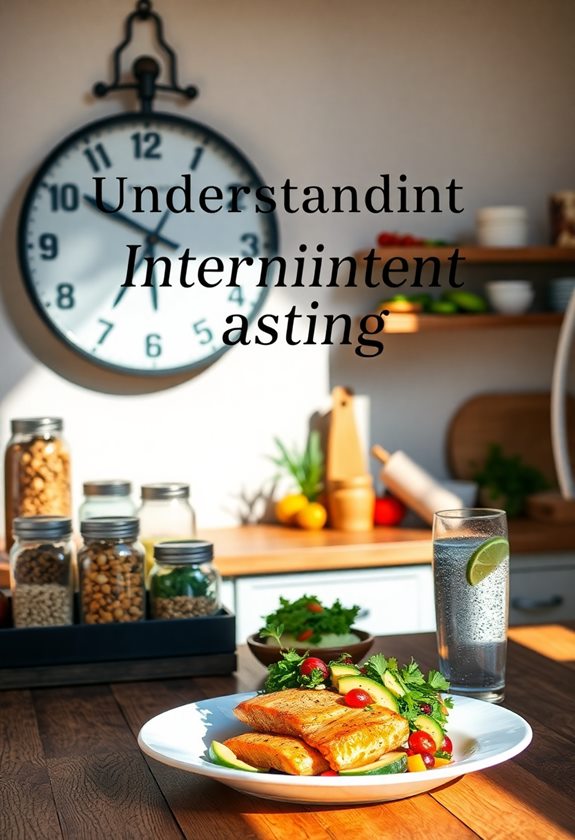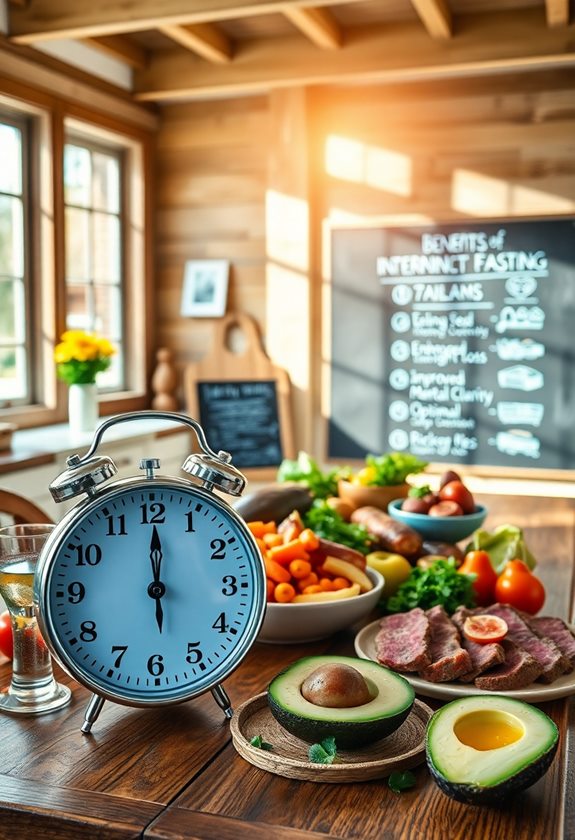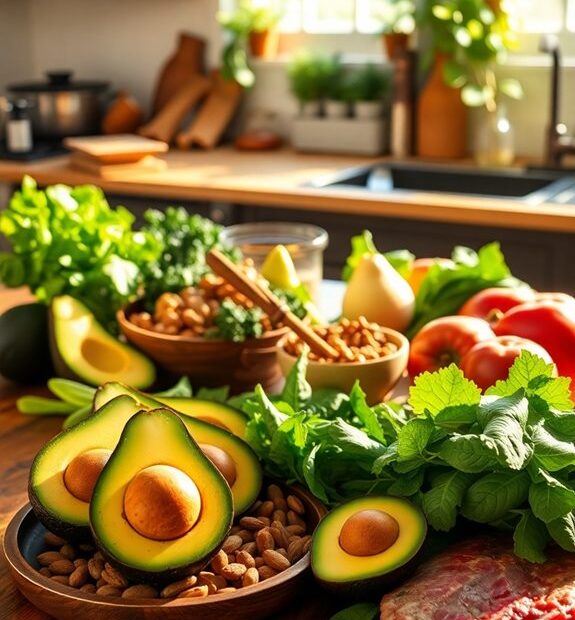Intermittent fasting and the Paleo diet make an awesome pair! 🥦 By focusing on when you eat and what you eat, you can enjoy tasty, nutrient-rich foods while managing your weight. Ever heard of the 16/8 fasting method? It lets you eat during an 8-hour window, helping control cravings. Plus, when you choose Paleo-friendly foods, like lean meats and veggies, you're cutting out sugars and processed stuff, boosting your energy. Isn't that exciting? 🎉 If you're curious about how to get started and stick with it, there's so much more to explore!
Key Takeaways
- Intermittent fasting enhances the benefits of the Paleo diet by promoting weight loss through reduced calorie intake and nutrient-dense food choices.
- Fasting periods allow for improved digestion, giving the gut a break from constant food intake, especially from processed foods.
- Combining both approaches can lead to increased energy levels by eliminating sugars and processed foods prevalent in traditional diets.
- Mental clarity is often reported during fasting, which complements the focus on whole, unprocessed Paleo foods.
- Preparing Paleo meals in advance aligns with fasting schedules, ensuring adherence to both dietary practices.
Understanding Intermittent Fasting

Intermittent fasting has gained popularity for its potential health benefits and simplicity. You might be wondering, what exactly is intermittent fasting? It's not about what you eat but when you eat. You cycle between periods of eating and fasting. For example, you may choose to eat during an 8-hour window each day and fast for the remaining 16 hours. Sounds easy, right? This method aligns well with structured meal planning, making it easier to maintain a balanced diet during your eating windows.
Many people find this approach helps them manage their weight and improve their health. Have you ever felt like you snack too much? Intermittent fasting can help curb those cravings. By focusing on a specific eating window, you might notice you're more mindful of your food choices. 🤔
Plus, some studies suggest that fasting can boost your metabolism and help your body repair itself. If you've got a busy lifestyle, you'll appreciate the simplicity of skipping breakfast or planning fewer meals.
The Paleo Diet Basics
When exploring dietary options, the Paleo diet stands out for its focus on whole, unprocessed foods reminiscent of our ancestors' eating habits. Have you ever wondered what our ancestors ate? The Paleo diet encourages you to eat like they did, emphasizing foods that are natural and nutrient-dense. Many people find success by combining the Paleo diet with other approaches, such as the Mediterranean diet, which also promotes healthy eating through fresh ingredients and balanced meals, as highlighted in the best Mediterranean diet cookbooks.
So, what's on the menu? You'll enjoy lean meats, fish, fruits, vegetables, nuts, and seeds. These foods provide the building blocks your body needs. But you'll want to avoid grains, legumes, dairy, and processed items. Why? These foods weren't part of our ancestors' diets and can sometimes cause issues for modern eaters.
Imagine biting into a juicy steak or snacking on crunchy almonds. Doesn't that sound delicious? With the Paleo diet, you're not just counting calories; you're fueling your body with quality ingredients.
As you immerse yourself in this lifestyle, think about how it makes you feel. Are you more energetic? Are you enjoying cooking with fresh ingredients? The goal is to reconnect with your food and enjoy every bite. By embracing the Paleo diet, you're taking a step towards healthier eating habits that could transform your life.
Benefits of Combining Both

Combining the Paleo diet with intermittent fasting can offer a powerful approach to health and wellness. When you eat whole foods and give your body time to rest from eating, you might see amazing changes. Have you ever wondered how these two methods can work together? Here are some benefits to evaluate:
| Benefit | Description |
|---|---|
| Weight Loss | Fasting helps reduce calorie intake, while Paleo focuses on nutritious foods. |
| Better Digestion | Giving your body breaks from food can improve gut health. |
| Increased Energy | You may feel more energized without the constant intake of sugar and processed foods. |
| Mental Clarity | Some people report improved focus and mental sharpness when fasting. |
| Reduced Cravings | Eating Paleo can help stabilize blood sugar, reducing cravings. |
How to Start Intermittent Fasting
Starting intermittent fasting can seem intimidating, but it's easier than you might think. You don't need to change everything at once. Just take it step by step! Ready to give it a shot? Here's how to start:
- Choose Your Method: Decide on a fasting schedule that fits your lifestyle. Popular options include the 16/8 method, where you fast for 16 hours and eat during an 8-hour window, or the 5:2 method, where you eat normally for five days and restrict calories for two. Consider incorporating strategies from calorie counting and portion control guides to enhance your meal planning and tracking.
- Stay Hydrated: During your fasting hours, drink plenty of water! It'll help keep you feeling full and energized. Herbal teas or black coffee are great too. What do you usually enjoy sipping on?
- Listen to Your Body: Pay attention to how you feel. If you're too hungry or tired, it's okay to adjust your fasting window. Your comfort matters!
Paleo-Friendly Foods to Include

To thrive on a Paleo diet, you'll want to focus on whole, unprocessed foods that mimic what our ancestors ate. This means choosing foods that are natural and nutritious. Have you ever thought about the types of food that have been around for ages? Here are some great options to include in your meals:
| Proteins | Vegetables | Fruits |
|---|---|---|
| Grass-fed beef | Spinach | Berries (strawberries, blueberries) |
| Free-range chicken | Broccoli | Apples |
| Wild-caught fish | Cauliflower | Bananas |
| Eggs | Kale | Oranges |
Eating these foods can help you feel full and satisfied. Plus, they're packed with nutrients that your body craves. When you load your plate with colorful veggies and lean proteins, you not only nourish your body but also keep your energy levels high.
Have you tried incorporating these foods into your meals? You might find that they taste amazing and make you feel great! Enjoy experimenting with different recipes to discover what you love. 🌱🥩🍏
Tips for Successful Integration
Integrating intermittent fasting with a Paleo lifestyle can be seamless and rewarding if you follow a few key tips. You might wonder how to make this work without feeling deprived. Here are some simple strategies to help you succeed:
- Start Slow: If you're new to fasting, begin with shorter fasting windows, like 12 hours, before gradually increasing to 16 hours or more. This way, your body can adjust without stress.
- Plan Your Meals: Make sure to prepare your meals in advance. It's easier to stay on track when you know what you're eating. Focus on whole foods like lean meats, veggies, and healthy fats.
- Stay Hydrated: Drink plenty of water during your fasting periods. It helps curb hunger and keeps you feeling fresh. Herbal teas can also be a great option!

